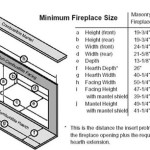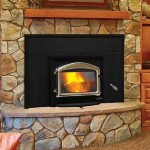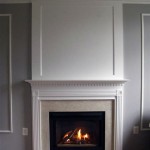Wood Burning Fireplace Insert: A Comprehensive Guide
A wood burning fireplace insert represents a significant upgrade for homeowners seeking to enhance the efficiency and aesthetic appeal of their existing masonry fireplaces. Traditional open-hearth fireplaces, while visually appealing, are notoriously inefficient, often drawing more heat out of the home than they provide. A well-chosen and properly installed wood burning fireplace insert addresses this issue by transforming an inefficient heat drain into a powerful and controllable heat source.
Wood burning fireplace inserts are self-contained units designed to fit directly into the opening of an existing fireplace. They typically feature a cast iron or steel firebox, surrounded by a decorative surround panel. A key component of an insert is the airtight door, which allows for controlled combustion and prevents the escape of smoke and harmful emissions into the home. Blower fans are often integrated into the design to circulate heated air into the room, maximizing heat distribution. The installation process usually involves connecting the insert to a dedicated chimney liner, which provides a safe and efficient pathway for exhaust gases to exit the home.
The primary purpose of a wood burning fireplace insert is to drastically improve the heating efficiency of a fireplace. Inefficient, open fireplaces can have extremely low efficiency ratings, sometimes even negative, as warm air escapes up the chimney. Wood burning inserts, especially those certified by the Environmental Protection Agency (EPA), can achieve efficiencies of 70% or higher. This means that a significantly larger percentage of the heat produced by burning wood is directed into the home rather than being lost up the chimney. This improved efficiency translates directly into reduced heating costs, as homeowners can rely more on the wood burning insert and less on their primary heating system.
Selecting the right wood burning fireplace insert involves careful consideration of several factors, including the size of the fireplace opening, the heating needs of the home, and the desired aesthetic. Measuring the fireplace opening accurately is crucial to ensure a proper fit. The insert should be slightly smaller than the opening to allow for adequate airflow and to facilitate installation. The heating needs of the home should be assessed based on the square footage of the area to be heated and the climate in which the home is located. Inserts are typically rated in terms of their heating capacity, measured in British Thermal Units (BTUs) per hour. Choosing an insert with an appropriate BTU rating is essential to effectively heat the desired space.
Key Point 1: Understanding the Benefits of a Wood Burning Fireplace Insert
The advantages of installing a wood burning fireplace insert are multifaceted. Beyond the obvious improvement in heating efficiency, inserts offer enhanced safety, reduced emissions, and increased convenience compared to traditional open fireplaces. The airtight door prevents sparks and embers from escaping, minimizing the risk of fire hazards. EPA-certified inserts are designed to burn wood more completely, reducing the amount of smoke and harmful pollutants released into the atmosphere. Many inserts also feature thermostatic controls, which allow for precise temperature regulation and extended burn times. The enclosed firebox also prevents drafts and minimizes the infiltration of cold air when the fireplace is not in use.
The potential for cost savings is a significant driver for many homeowners considering a wood burning fireplace insert. By supplementing or replacing their primary heating system with a wood burning insert, homeowners can significantly reduce their reliance on expensive fuels such as oil, propane, or electricity. The cost of wood varies depending on location and availability, but it is often a more economical alternative to these fuels, especially in rural areas where wood is plentiful. The initial investment in a wood burning insert can be recouped over time through reduced heating bills.
Beyond the practical benefits, wood burning fireplace inserts can also enhance the aesthetic appeal of a home. Inserts are available in a wide range of styles and finishes, from traditional to contemporary, allowing homeowners to choose an insert that complements their existing decor. The fire itself provides a warm and inviting ambiance, creating a cozy focal point in the room. The controlled burn of an insert also results in cleaner glass, allowing for a clearer view of the flames. Many inserts feature decorative fronts and accessories, such as ornate surrounds andirons, further enhancing their visual appeal.
Proper maintenance is essential to ensure the longevity and optimal performance of a wood burning fireplace insert. Regular cleaning of the firebox and chimney liner is necessary to remove creosote buildup, which is a flammable substance that can pose a fire hazard. The frequency of cleaning depends on the type of wood burned and the frequency of use, but annual inspections by a qualified chimney sweep are generally recommended. Ash should be removed from the firebox regularly to maintain proper airflow. The door gaskets should be inspected periodically and replaced as needed to ensure an airtight seal. Following the manufacturer's recommendations for maintenance will help to prolong the life of the insert and ensure safe and efficient operation.
Key Point 2: Selecting the Right Insert for Your Needs
Choosing the appropriate wood burning fireplace insert requires careful assessment of several factors. The size of the fireplace opening is a critical consideration. Accurate measurements of the height, width, and depth of the opening are essential to ensure a proper fit. Many manufacturers provide detailed specifications for their inserts, including the minimum and maximum fireplace opening dimensions. It is important to select an insert that falls within these specifications to avoid installation difficulties and potential safety hazards.
The heating capacity of the insert should be matched to the size and insulation of the area to be heated. Inserts are typically rated in terms of their BTU output, which indicates the amount of heat they can produce per hour. A larger area with poor insulation will require an insert with a higher BTU rating than a smaller, well-insulated area. Consulting with a qualified professional can help to determine the appropriate BTU rating for a specific home. Factors such as the climate, the number of windows, and the direction the house faces should also be taken into account.
EPA certification is an important consideration when selecting a wood burning fireplace insert. EPA-certified inserts meet stringent emission standards, ensuring that they burn wood more cleanly and efficiently than non-certified models. These inserts produce less smoke and harmful pollutants, making them a more environmentally friendly choice. Many municipalities offer rebates or tax credits for the purchase of EPA-certified inserts, further incentivizing their use. Choosing an EPA-certified insert is a responsible choice that benefits both the homeowner and the environment.
The design and style of the insert should complement the existing decor of the home. Inserts are available in a wide range of styles, from traditional to contemporary, with various finishes and features. Consider the overall aesthetic of the room and choose an insert that blends seamlessly with the existing furniture and accessories. Some inserts feature decorative fronts, such as cast iron or porcelain enamel, while others have a more minimalist design. The choice of style is ultimately a matter of personal preference.
The type of wood that will be burned is another important consideration. Different types of wood have different heating values and burn characteristics. Hardwoods, such as oak and maple, typically produce more heat and burn longer than softwoods, such as pine and fir. The insert should be compatible with the type of wood that will be used most frequently. Some inserts are designed specifically for burning hardwoods, while others can accommodate a wider range of wood types. Checking the manufacturer's recommendations for fuel type is crucial for optimal performance and safety.
Key Point 3: The Importance of Proper Installation and Maintenance
Professional installation is highly recommended for wood burning fireplace inserts. The installation process involves connecting the insert to a dedicated chimney liner, which provides a safe and efficient pathway for exhaust gases to exit the home. Improper installation can result in dangerous conditions, such as carbon monoxide poisoning or chimney fires. A qualified installer will have the necessary expertise and equipment to ensure that the insert is installed safely and correctly. They will also be able to advise on proper venting and clearances to combustible materials.
A dedicated chimney liner is essential for the safe and efficient operation of a wood burning fireplace insert. Traditional masonry chimneys are often too large to properly vent the exhaust gases from an insert, which can lead to creosote buildup and reduced draft. A properly sized chimney liner provides a tighter seal and ensures that the exhaust gases are vented efficiently. The liner should be made of stainless steel or another durable material that is resistant to corrosion. Regular inspections of the chimney liner are necessary to ensure that it remains in good condition.
Regular cleaning and maintenance are crucial for the longevity and optimal performance of a wood burning fireplace insert. Creosote, a flammable substance that accumulates in the chimney, should be removed regularly to prevent chimney fires. The frequency of cleaning depends on the type of wood burned and the frequency of use, but annual inspections by a qualified chimney sweep are generally recommended. The firebox should be cleaned regularly to remove ash and debris, which can impede airflow. The door gaskets should be inspected periodically and replaced as needed to ensure an airtight seal.
Proper operation of the wood burning fireplace insert is essential for safety and efficiency. Avoid burning wet or green wood, as it produces more smoke and creosote. Use seasoned wood that has been dried for at least six months. Do not overload the firebox, as this can lead to incomplete combustion and excessive smoke. Follow the manufacturer's instructions for starting and maintaining a fire. Never leave a fire unattended, and always use a spark screen to prevent embers from escaping.
By carefully considering these factors and following proper installation and maintenance procedures, homeowners can enjoy the many benefits of a wood burning fireplace insert. From improved heating efficiency to enhanced aesthetic appeal, these inserts offer a valuable upgrade to any home with an existing masonry fireplace. The key is to select the right insert for the specific needs and preferences of the homeowner and to ensure that it is installed and maintained properly for years of safe and efficient operation.

Benefits Of Installing A Wood Burning Fireplace Insert

Wood Burning Fireplace Inserts Insert Installation

Why A Wood Burning Fireplace Insert Bethesda Md Service

Ventis Hei240 Wood Burning Insert Rockford Chimney

Lopi Premium Wood Fireplace Inserts Custom Hearth Fireplaces And Stoves

Wood Inserts We Love Fire

Wood Burning Fireplace Inserts Installation In Augusta Ga Aiken Sc

Should I Use A Fireplace Insert Or Wood Stove To Heat Up My Home

Hi500 Hybrid Catalytic Cast Iron Wood Burning Insert By Regency

We Install Fireplaces Inserts And Stoves Top Fireplace Brands
Related Posts








